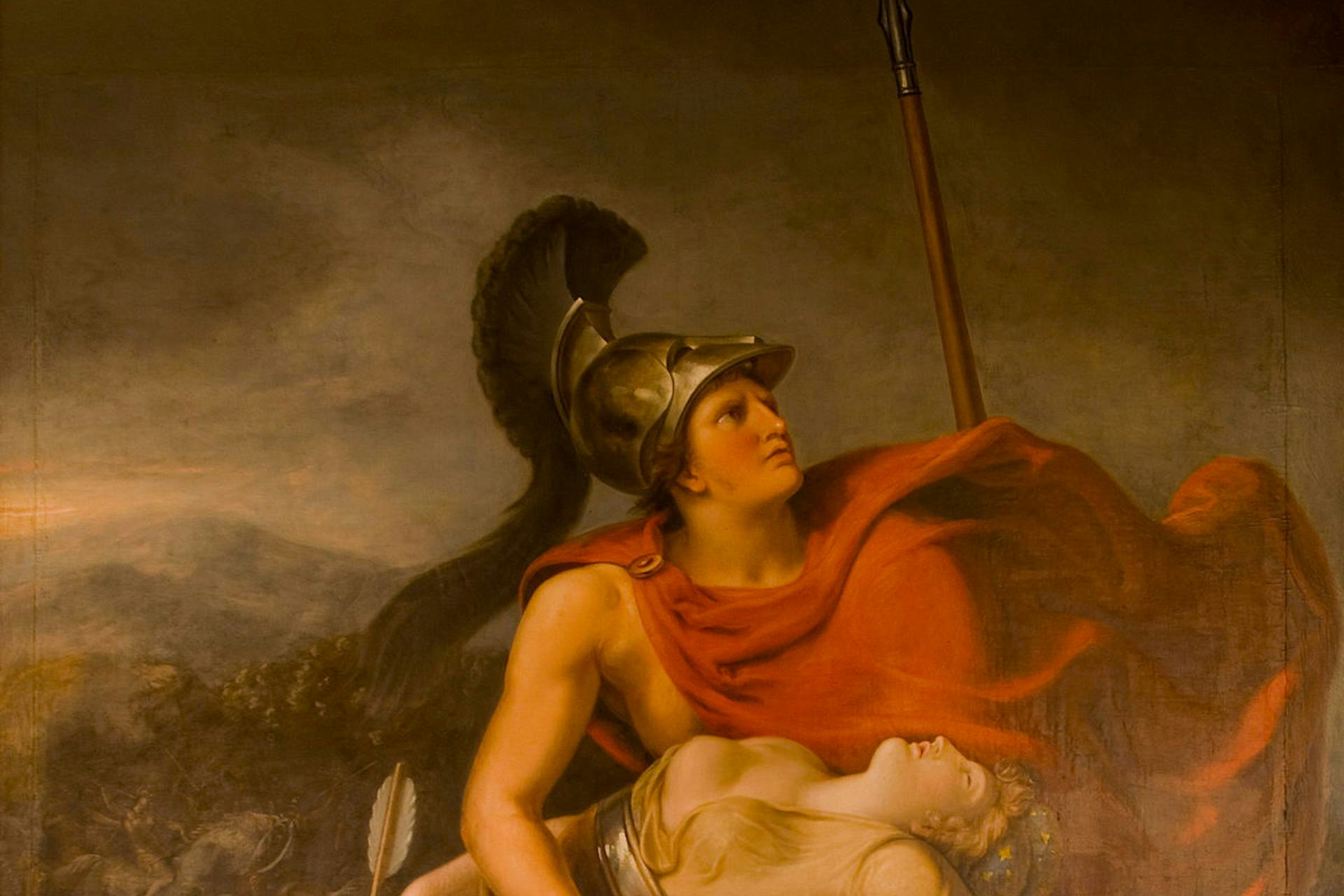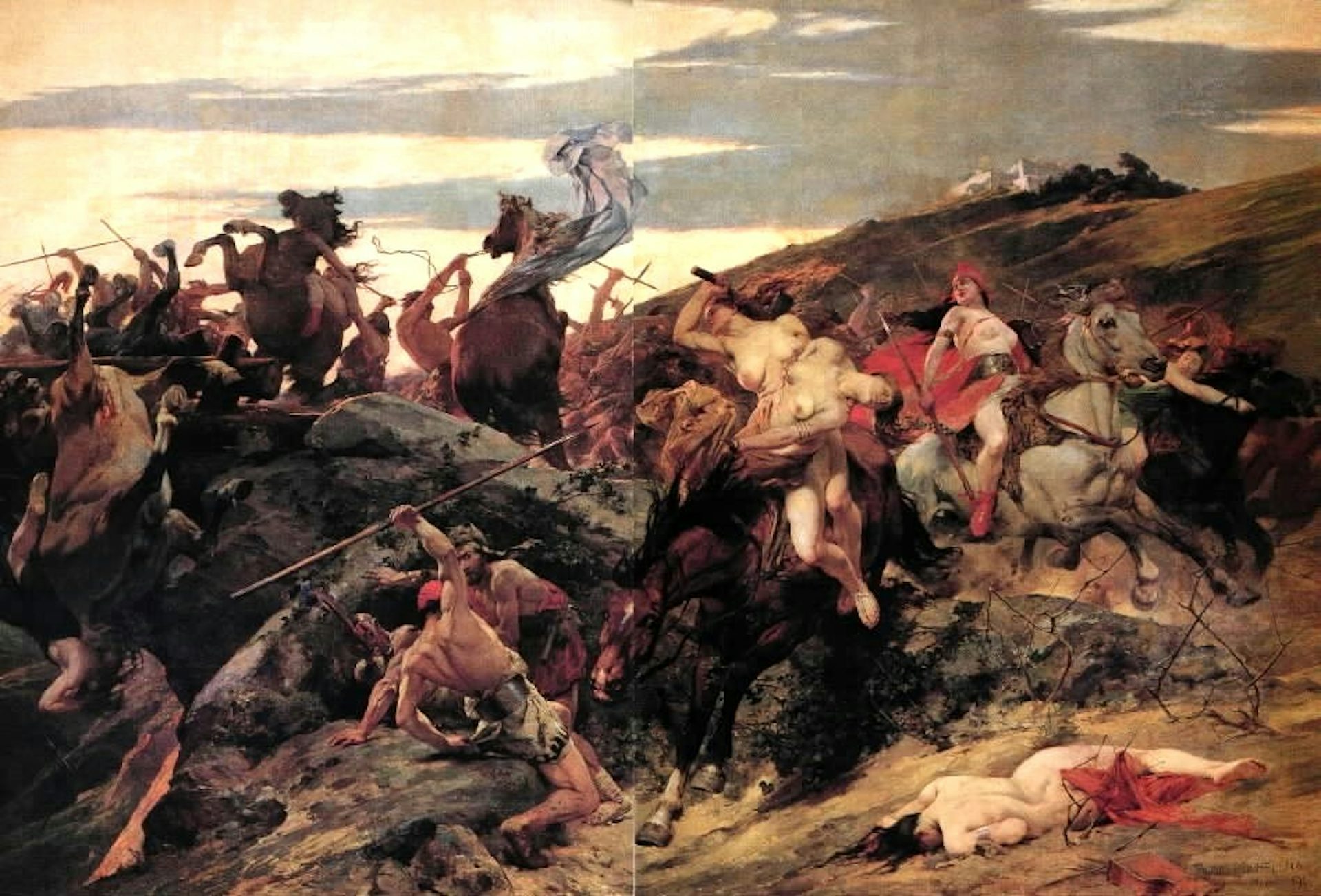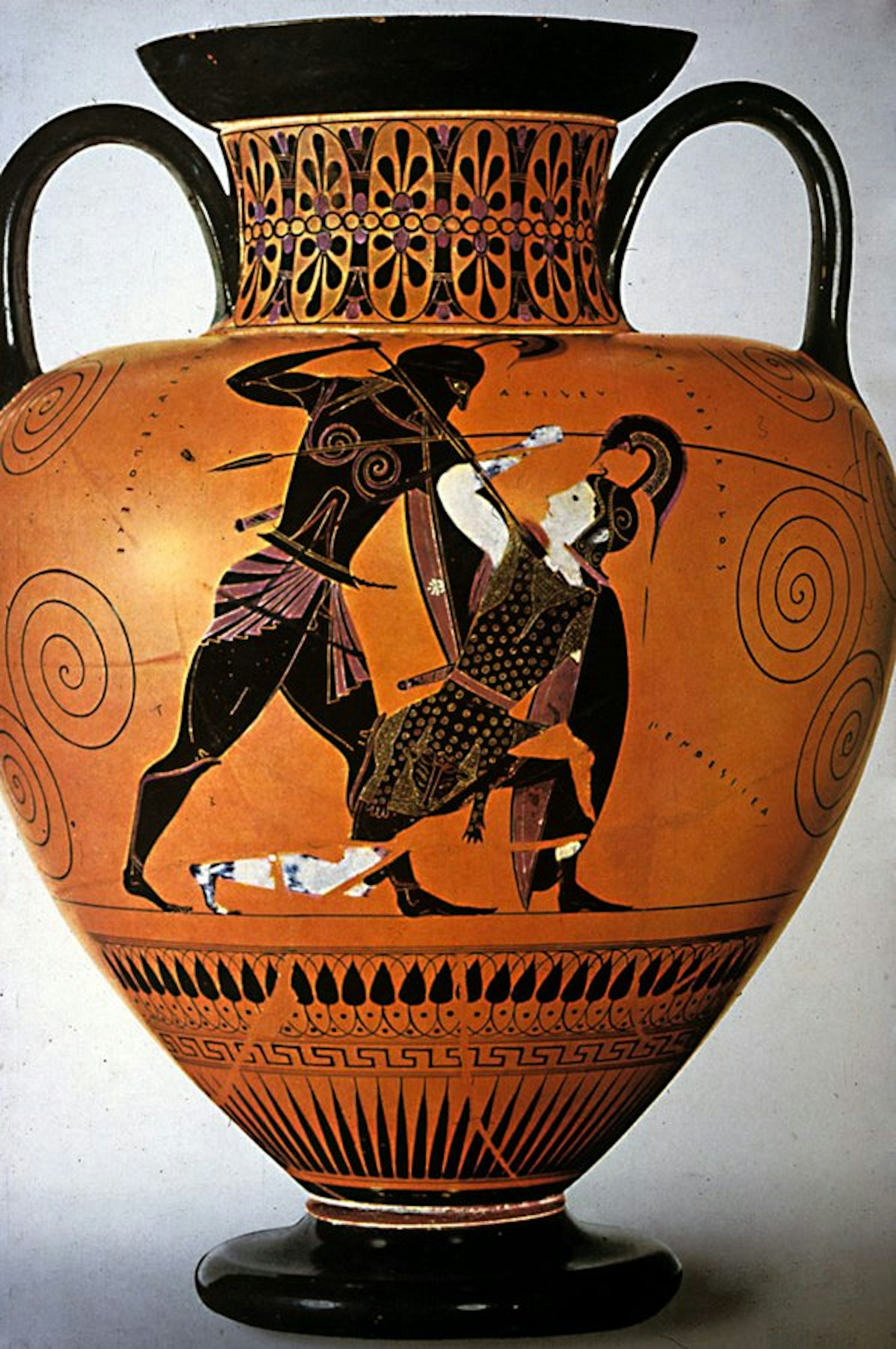Penthesilea

Achilles and Penthesilea by Johann Heinrich Wilhelm Tischbein (ca. 1823).
Wikimedia CommonsPublic DomainOverview
Penthesilea, daughter of Ares and Otrera, was an Amazon queen who fought and died in the Trojan War. After Hector, the leader of the Trojan army, was killed in the final year of the war, Penthesilea arrived with a small but highly skilled troop of Amazon warriors to help the doomed city against the Greeks. Penthesilea slew many Greeks before being killed in turn by Achilles, the greatest of the Greek warriors at Troy. But when Achilles stripped Penthesilea of her armor and beheld her beauty, he fell in love with the fallen queen.
Etymology
Penthesilea’s name no doubt derives from the Greek root penth-, encountered in the verb pentheō (“to grieve, sorrow”) and the noun penthos (“grief, sorrow”). Penthesilea, then, can be translated as “She who brings grief”—an appropriate name considering the pain she caused to both her enemies and her allies.
Pronunciation
English
Greek
Penthesilea Πενθεσίλεια Phonetic
IPA
[pen-the-si-LAY-uh] /pɛnˌθɛ sɪˈleɪə/
Attributes and Iconography
Like all Amazons, Penthesilea was a skilled warrior. But she was also extraordinarily beautiful—so beautiful that just one glimpse of her dead body caused the hardened hero Achilles to fall in love with her. Quintus of Smyrna gives a detailed description of the stunning Penthesilea in his Posthomerica:
in her face glowed beauty glorious and terrible. Her smile was ravishing: beneath her brows, her love-enkindling eyes shone like to stars, and with the crimson rose of shamefastness bright were her cheeks, and mantled over them unearthly grace with battle-prowess clad.[1]
In ancient art, Penthesilea was represented as a young woman wearing exotic armor, like other Amazon warriors. Her death at the hands of Achilles was a popular subject of painters from the middle of the sixth century BCE.[2]
Family
Penthesilea was the daughter of Ares, the Greek god of war, and the Amazon Otrera.[3] Her sisters included other famous Amazons of Greek myth, including Hippolyta, Antiope, Melanippe, and Orithyia.
Family Tree
Parents
Father
Mother
- Otrera
Siblings
Sisters
- Antiope (daughter of Ares)
- Hippolyta
- Melanippe
- Orithyia
Children
Son
- Caustrus
Mythology
Troy and Achilles
During the tenth and final year of the Trojan War, Penthesilea arrived in Troy with a small but fierce band of warriors to defend the city. The war had been instigated when the Trojan prince Paris carried off Helen, the beautiful wife of the Greek king Menelaus. To get Helen back, Menelaus and the other Greek kings gathered a massive army and attacked Troy. The Trojans put up a valiant defense, bringing in allies from all over Asia Minor. Penthesilea was one of the last allies of the doomed city.
According to some authors, Penthesilea came to Troy after accidentally killing her sister Hippolyta. While they were hunting together, Penthesilea’s spear missed its mark and struck Hippolyta instead. A grieving Penthesilea went to Troy to be purified of her blood-guilt by Priam, the king. Afterwards, she and her warriors thanked Priam by helping him fight the Greeks.[5]
For a time—just a single day in most accounts—Penthesilea dominated the battlefield and killed many Greeks. But she was finally slain by Achilles, the greatest of the Greek warriors at Troy.

Penthesilea by Arturo Michelena (1891). Instituto Autonomo Circulo Militar de las Fuerzas Armadas, Caracas, Venezuela.
Wikimedia CommonsPublic DomainWhen Achilles stripped Penthesilea of her armor (it was common practice in antiquity to take the armor of a defeated opponent as a trophy), he was struck by her beauty. Quintus of Smyrna vividly represents the sight:
In her armour there upon the earth she lay, and seemed the Child of Zeus, the tireless Huntress Artemis sleeping, what time her feet forwearied are with following lions with her flying shafts over the hills far-stretching. She was made a wonder of beauty even in her death by Aphrodite glorious-crowned, the Bride of the strong War-god, to the end that he, the son of noble Peleus, might be pierced with the sharp arrow of repentant love. The warriors gazed, and in their hearts they prayed that fair and sweet like her their wives might seem, laid on the bed of love, when home they won. Yea, and Achilles' very heart was wrung with love's remorse to have slain a thing so sweet, who might have borne her home, his queenly bride, to chariot-glorious Phthia; for she was flawless, a very daughter of the Gods, divinely tall, and most divinely fair.[6]
When the Greeks saw Achilles grieving for Penthesilea, most pitied him. But one Greek warrior—Thersites, known as the ugliest of the Greeks—taunted Achilles for falling in love with his fallen enemy. According to some accounts, Thersites accused Achilles of necrophilia or even gouged out the dead Penthesilea’s eyes.[7] In a burst of rage, Achilles struck Thersites and killed him where he stood.

Amphora depicting Achilles and Penthesilea. Attributed to Exekias (530–525 BCE). British Museum, London, UK.
aaron wolpertCC BY 2.0Some traditions state that Achilles then honored Penthesilea with a funeral near Troy or gave her body to the Trojans for burial.[8] But according to another version, the murder of Thersites enraged Diomedes, a relative of Thersites and another Greek hero fighting at Troy, who threw Penthesilea’s body into a river in revenge.[9]
Other Versions
Though in the common tradition Penthesilea fought on the side of the Trojans and died at Achilles’ hand, there were other versions of her myth.
In one strange variant, Penthesilea actually killed Achilles when she met him in battle. But Achilles’ mother Thetis, who was a sea goddess, brought Achilles back to life so that he could kill Penthesilea. Afterwards, Achilles returned to the Underworld.[10]
In another variant, Penthesilea only came to Troy’s aid after Achilles had been defeated. Instead of falling to Achilles, then, this version of Penthesilea fell to his son Neoptolemus.[11]
Pop Culture
Perhaps the most famous modern treatment of the myth of Penthesilea is the 1808 drama Penthesilea by Heinrich von Kleist. This work—in which Penthesilea kills Achilles, rather than the other way around—continues to be performed and adapted today.
Another literary rendition of the myth can be found in Robert Graves’ poem “Penthesilea.” Graves offers a disturbing interpretation of the myth, in which
Prince Achilles
… for love of that fierce white naked corpse,
Necrophily on her committed
In the public view.[12]
This tableau is a reference to the variant (also attested in antiquity) in which Achilles had sex with Penthesilea’s corpse, or was at least accused of doing so (see above).
Penthesilea has also played an important role in various modern novels based on the myth of the Trojan War, including Christa Wolf’s Cassandra (1983) and Marion Zimmer Bradley’s The Firebrand (1987).
More recently, Penthesilea appeared in the 2018 BBC television miniseries Troy: Fall of a City.
Finally, the asteroid 271 Penthesilea, discovered in 1887, was named after the mythical Amazon queen.